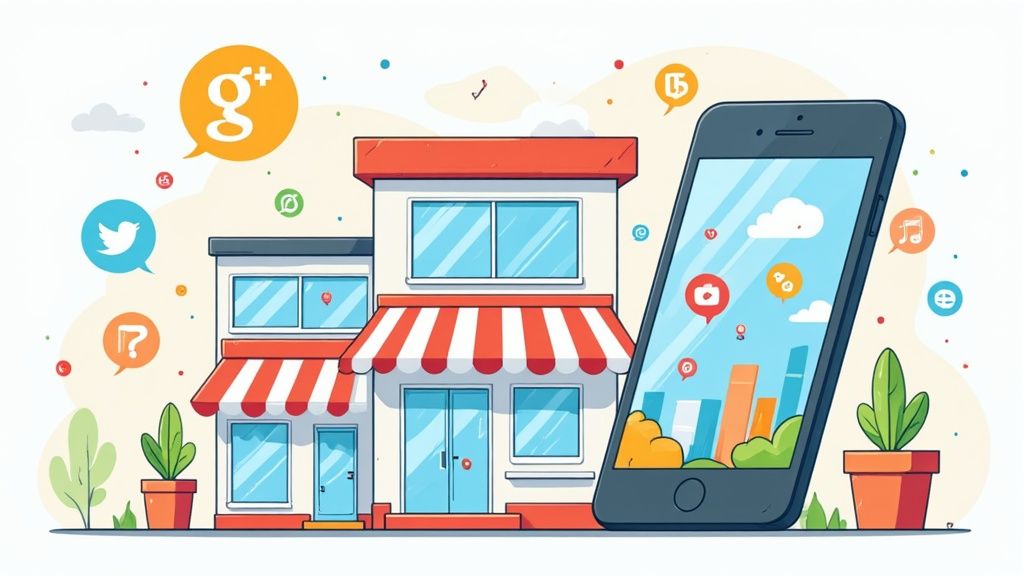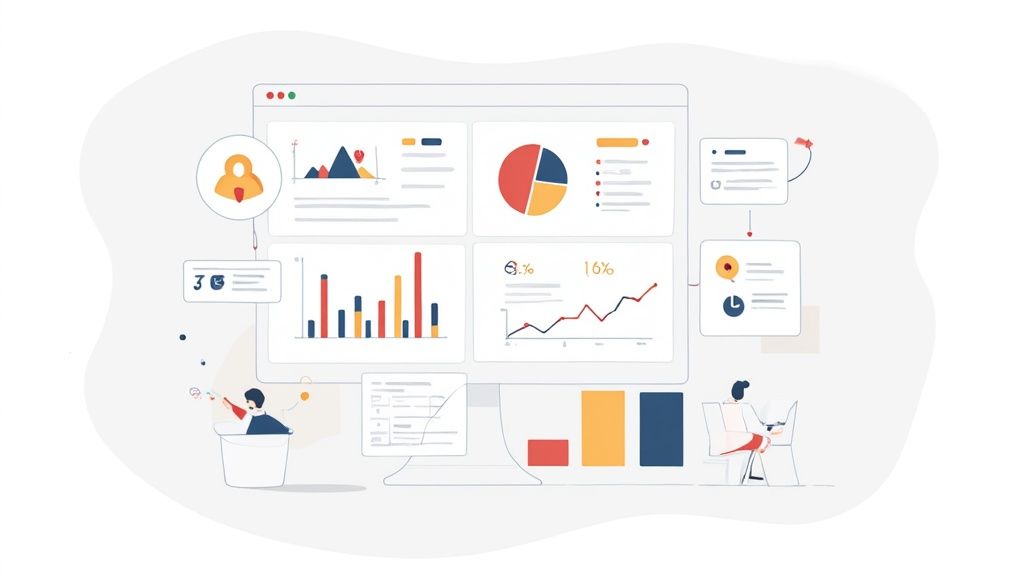Why Digital Marketing Transforms Small Business Success

Digital marketing is no longer just a useful tool for small businesses; it’s essential for survival and growth. Consumer behavior has shifted dramatically, with people increasingly relying on online searches and social media platforms like Instagram to find and interact with businesses. This presents a powerful opportunity for small businesses to connect directly with their target audience, often surpassing the effectiveness of traditional advertising.
Even with limited resources, small businesses can compete with larger corporations using digital platforms. Think of it like a local bakery versus a large supermarket chain. The bakery may not have a huge advertising budget, but it can cultivate a loyal customer base by offering unique products and building a sense of community. Digital marketing empowers small businesses to showcase their strengths and foster genuine customer relationships.
Debunking the Myths of Digital Marketing for Small Businesses
Many small business owners believe digital marketing is too complicated or expensive. However, numerous free and low-cost tools are readily available for managing social media, email marketing campaigns, and basic SEO. The focus on authenticity in the digital world often favors small businesses. A highly polished corporate campaign may not resonate as much as a genuine story from a small business owner.
A small restaurant, for example, can share behind-the-scenes photos of their kitchen on Instagram, creating a personal connection with followers. They can engage directly with customers in the comments, answering questions and building relationships. These authentic interactions are invaluable for fostering customer loyalty and are often difficult for larger corporations to replicate.
The Growing Importance of Digital Marketing for Small Businesses
Digital marketing’s measurable nature allows small businesses to track progress and adapt strategies. They can see exactly how many people visit their website, engage with social media posts, or open emails. This data-driven approach enables campaign optimization for maximum impact, even on tight budgets. The increasing adoption of digital strategies underscores this point. 58% of small businesses use digital marketing, with 75% using at least two marketing channels, and 80% focusing on digital advertising to drive success. Find more detailed statistics here. This clearly shows that small businesses are recognizing the power of digital marketing to reach wider audiences, strengthen customer relationships, and ultimately, fuel growth.
Crafting a High-Impact Strategy Without Breaking the Bank

Building a successful digital marketing strategy for a small business doesn’t require a huge budget. What it does require is smart planning and a deep understanding of your target audience. Instead of trying to do everything at once, concentrate on a targeted approach that aligns with your specific business goals. This begins with identifying your core strengths and showcasing them through a compelling online presence.
Identifying Your Competitive Advantages
What makes your business stand out? What unique value do you offer your customers that your competitors don’t? These are your competitive advantages, and they should be the foundation of your small business digital marketing strategy. For example, if you own a local bakery, your competitive advantage might be handcrafted bread made with locally sourced ingredients, personalized birthday cakes, or a warm and inviting atmosphere that large chain stores can’t replicate.
Budget Allocation for Maximum Impact
After pinpointing your competitive advantages, it’s essential to determine how to best allocate your marketing budget. This often involves prioritizing certain digital channels over others. A service-based business might focus on SEO and content marketing, while an e-commerce store might prioritize paid advertising and social media marketing. Think carefully about your target audience and where they are most active online.
Strategic spending is increasingly important in the world of digital marketing. The global digital marketing market is expected to reach $472.5 billion by 2025, expanding at a 13.6% rate until 2033. Furthermore, North American and European companies allocate 7.7% of their total revenue to marketing, with more than half dedicated to paid media and marketing technology. This highlights the increasing influence of digital channels, especially for small businesses. More detailed statistics can be found here: https://www.hostinger.com/tutorials/digital-marketing-statistics. Even with limited resources, these trends underscore the importance of strategic digital marketing for small business growth.
To help you determine the right budget split, consider the following table as a starting point:
To help illustrate effective budget allocation, the following table provides a general guideline. Remember, these are just suggestions and your actual allocation should be based on your specific business needs and goals.
Digital Marketing Budget Allocation for Small Businesses
This table shows recommended budget allocation percentages for different digital marketing channels based on business type and goals.
| Marketing Channel | Service Business | E-commerce | Local Retail | B2B |
|---|---|---|---|---|
| SEO | 30% | 20% | 25% | 25% |
| Paid Advertising | 15% | 35% | 20% | 20% |
| Social Media Marketing | 25% | 25% | 30% | 20% |
| Content Marketing | 20% | 10% | 15% | 25% |
| Email Marketing | 10% | 10% | 10% | 10% |
This table emphasizes the importance of aligning your budget with your business type. For example, e-commerce businesses may allocate a larger portion to paid advertising, while service businesses may focus more on SEO and content marketing. Local retail often benefits from a strong social media presence, and B2B businesses may find success with content and SEO.
Setting Realistic Goals and Timelines
One common pitfall for small businesses is setting unrealistic goals and overly ambitious timelines. This can quickly lead to burnout and discouragement. Instead, focus on achieving small, measurable victories. For example, instead of striving to double your website traffic in a month, aim for a 10% increase each week. Break down larger projects into smaller, more manageable tasks. This approach simplifies the overall process and makes it easier to track your progress.
Choosing the Right Digital Channels
Choosing the right digital channels is critical for maximizing your return on investment. While having a presence across multiple platforms can be beneficial, concentrating on the channels where your target audience is most active is key. For instance, a business targeting a younger demographic might thrive on platforms like Instagram or TikTok, while a B2B company may find greater success on LinkedIn. Analyze your audience’s online behavior and choose the channels that align best with your business objectives and available resources. This focused approach helps ensure your message reaches the right people at the optimal time.
Social Media Strategies That Actually Drive Business Results

Successfully using social media for business involves more than just posting occasional updates. It’s about strategically leveraging these platforms to drive tangible growth. For small businesses, this means choosing the right platforms, crafting compelling content, and cultivating a loyal community. It’s about understanding your audience and how they interact online to maximize your impact, even with limited resources.
Choosing the Right Platforms for Your Business
Different social media platforms cater to different audiences and content formats. What works for one business might not work for another. A visually-driven business, such as a clothing boutique, might thrive on Instagram, using high-quality images and videos to showcase its products. A B2B company, however, might find LinkedIn more effective for networking and sharing industry insights. Identifying the platforms where your target audience is most active is crucial for effective digital marketing for small businesses. This focused approach ensures your message reaches the right people.
Content Creation That Resonates With Your Audience
Creating engaging social media content doesn’t necessarily require professional-level design skills. Authenticity is often more valuable than polished production. A simple behind-the-scenes photo of your team or a short video addressing a customer question can be remarkably effective. A local restaurant, for instance, might share a video of their chef preparing a signature dish, highlighting the freshness of their ingredients and their culinary expertise. Social media provides a unique opportunity to humanize your brand and connect with your customers on a deeper level.
This is particularly important as social media’s influence continues to rise. Currently, 33% of small businesses now concentrate most of their digital marketing efforts on social media, a substantial increase from pre-pandemic numbers. Remarkably, over 20% of small businesses now use social media instead of a website. More detailed statistics can be found here: https://fitsmallbusiness.com/digital-marketing-statistics/. This highlights the growing importance of social media as a central component of digital marketing for small businesses, especially for direct audience engagement.
Building a Community and Fostering Customer Loyalty
Social media offers a powerful way to build authentic relationships with your customers. Responding promptly to comments and messages, actively participating in conversations, and demonstrating genuine interest in your followers cultivates trust and loyalty. Treat your social media profiles as an extension of your customer service. When customers feel valued, they’re more likely to become brand advocates, recommending your business to their networks.
Streamlining Your Social Media Workflow
Maintaining a consistent social media presence can be demanding, especially for busy small business owners. Fortunately, implementing simple workflow systems can significantly save time and effort. This could involve scheduling posts in advance using tools like Buffer or Hootsuite, repurposing existing content, or delegating social media management tasks to a team member. By streamlining their social media processes, small businesses can maintain consistent engagement without neglecting other important responsibilities.
Measuring Results and Adapting Your Strategy
Just like any other marketing initiative, tracking the results of your social media activities is crucial. Focus on metrics that directly align with your business objectives, such as website traffic, lead generation, or sales. By monitoring your performance, you can identify what’s working, what’s not, and adapt your strategy accordingly. For instance, if a particular content format consistently generates high engagement, create more of that type of content. If a specific platform isn’t yielding results, consider reallocating your resources.
SEO Essentials: Getting Found When Customers Are Looking

For small businesses, high search result rankings are essential for online visibility. This section simplifies search engine optimization (SEO), offering practical advice for small business owners. We’ll explore how successful local businesses achieve top rankings without large teams or extensive technical expertise. It starts with understanding customer search habits and optimizing your online presence accordingly.
Understanding Your Customer’s Search Intent
Effective SEO begins with understanding search intent. What terms do customers use when searching for products or services like yours? For example, someone searching for a local bakery might use phrases like “best sourdough bread near me” or “custom birthday cakes.” Identifying these keywords is fundamental to digital marketing for small businesses. These keywords will shape your content and website optimization strategies.
Optimizing Your Website Content
After identifying relevant keywords, incorporate them naturally into your website content. This includes page titles, headings, meta descriptions, and the body of your text. Avoid keyword stuffing, or overusing keywords. Focus on creating high-quality, informative content that provides genuine value to your audience. This means creating engaging and informative content for your target audience, strategically using keywords to highlight relevance for search engines.
Local SEO Tactics for Small Businesses
For local businesses, local SEO is crucial. This involves claiming and optimizing your Google My Business profile. Ensure your business name, address, phone number (NAP), and hours are accurate and current. Encourage satisfied customers to leave reviews. Positive reviews build trust and improve local search ranking, acting like digital word-of-mouth referrals.
Building Backlinks to Boost Your Authority
Backlinks, links from other websites to yours, are vital for SEO. They act as endorsements, signaling to search engines that your website is a trusted source. Build backlinks by creating high-quality, shareable content, guest posting on relevant blogs, or participating in industry forums. Building relationships within your community can also create valuable backlink opportunities. These backlinks function as trusted referrals, increasing your search engine credibility.
Simple Website Optimizations for Improved Search Performance
Beyond content and backlinks, simple website optimizations can significantly improve search performance. Ensure your website is mobile-friendly, loads quickly, and is easy to navigate. A user-friendly website provides a positive experience for visitors and signals quality to search engines. These technical aspects influence user experience and, ultimately, search ranking. A streamlined website improves customer satisfaction and boosts visibility in search results. This combined approach of content strategy, local SEO, backlink building, and technical optimization forms a strong foundation for small business digital marketing success.
Content Marketing That Converts Browsers Into Buyers
Content marketing offers small businesses a powerful way to connect with customers, build trust, and showcase their expertise. It’s not about churning out mountains of content. Instead, focus on creating targeted material that addresses specific customer needs and positions your products or services as the solution. This approach builds stronger, longer-lasting customer relationships.
Identifying High-Impact Content Topics
Effective content marketing starts with understanding your audience. What problems are they facing? How can your business help them overcome these challenges? Consider a local bakery, for example. They could create blog posts or videos with baking tips, delicious recipes, or even a behind-the-scenes look at their daily operations. This offers valuable content while subtly showcasing their expertise and product quality. This helps convert casual visitors into loyal customers.
Content Development Strategies for Small Businesses
Creating high-quality content doesn’t have to strain your resources. Small businesses can get more mileage from each piece of content by repurposing it across various platforms. A single blog post, for instance, can be transformed into a series of social media updates, an informative infographic, or even a short, engaging video. This broader reach doesn’t require starting from scratch each time.
Creating a Sustainable Content Calendar
Consistency is key for successful content marketing. But maintaining a consistent output can be a challenge. A content calendar helps organize content creation and ensures a steady stream of valuable material for your audience. Quality over quantity is important here. A sustainable content schedule might involve one high-quality blog post per month, combined with regular social media engagement. This manageable approach prevents content creation from becoming overwhelming.
Measuring Content Marketing ROI
Tracking your content marketing results is essential for continuous improvement. Focus on key metrics tied to your business goals, such as website traffic, lead generation, and, ultimately, sales. Tools like Google Analytics provide valuable insights into content performance. Analyzing this data helps identify which content resonates best and refine your strategy accordingly. This data-driven approach ensures your content marketing efforts directly contribute to business growth. To better understand which content formats might yield the best results for your business, review the following table:
Content Marketing ROI by Format for Small Businesses
This table presents data on which content formats provide the best return on investment for small businesses based on industry type and marketing goals.
| Content Format | Average Time Investment | Lead Generation Potential | Customer Retention Value | Best For |
|---|---|---|---|---|
| Blog Posts | High | Medium | High | Building authority, driving organic traffic |
| Social Media Updates | Low | Low | Medium | Brand awareness, community building |
| Videos | Medium | High | High | Product demonstrations, tutorials |
| Infographics | Medium | Medium | Medium | Data visualization, simplifying complex topics |
| Email Newsletters | Low | Medium | High | Nurturing leads, promoting offers |
This table provides a general guideline. The actual ROI will vary based on factors like your industry, target audience, and specific business objectives. By analyzing your own data and adjusting your strategy, you can identify the best content formats within your available resources. This targeted approach optimizes your content marketing for maximum impact, converting website visitors into loyal, paying customers.
Email Marketing: Your Most Powerful Revenue Generator
While social media and other channels might grab the spotlight, email marketing remains a bedrock of successful digital marketing for small businesses, consistently providing a strong return on investment. This section explores practical ways small businesses can create effective email programs that drive revenue without needing complex systems. We’ll delve into building a robust email list, segmenting your audience, and automating your messaging for maximum impact.
Building Your Email List: The Foundation of Success
A healthy email list is the cornerstone of any successful email marketing strategy. This means offering valuable incentives that encourage sign-ups. Think of offering a complimentary appetizer at a restaurant. It entices guests to explore the menu and ultimately order more. In the digital world, your “appetizer” could be a discount code, a helpful guide, or exclusive access to valuable content.
Strategically placing sign-up forms on your website, social media profiles, and at checkout maximizes your opportunities to capture leads. For example, an online retailer could offer a 10% discount to new subscribers, encouraging sign-ups while also boosting sales. This dual-purpose approach effectively builds your email list while also driving immediate purchases.
Segmentation and Personalization: Sending the Right Message to the Right Person
Imagine sending the same flyer to every household, regardless of their needs. It’s inefficient and likely to end up in the recycling bin. Email marketing is no different. Segmentation, dividing your audience into smaller groups based on shared characteristics, lets you send targeted, relevant messages. A pet store, for instance, could segment its list into dog owners, cat owners, and bird owners, sending each group personalized product recommendations. This focused approach boosts engagement and, ultimately, drives sales.
Email Automation: Working Smarter, Not Harder
Email automation allows you to send timely, relevant messages without manual effort. This is especially helpful for small businesses with limited resources. Consider a welcome email series that automatically greets new subscribers, introduces your business, and offers a special promotion. This automated approach nurtures new leads without constant oversight. It’s like having a dedicated team member working around the clock, greeting customers and guiding them through their journey.
Crafting High-Performing Emails: Getting Opens, Clicks, and Conversions
Effective emails capture attention from the subject line to the call to action. Think of your subject line as a store’s window display—it needs to be eye-catching to draw customers in. A compelling subject line, like “Exclusive Offers Just for You,” is more likely to be opened than a generic one. Clear, concise content, engaging visuals, and a distinct call to action guide the reader towards the desired outcome, whether it’s making a purchase, exploring your website, or learning more about your services.
Testing and Optimization: Continuously Improving Your Results
Just as a chef refines recipes based on customer feedback, consistently testing and optimizing your email campaigns is crucial. A/B testing, comparing two versions of an email to see which performs better, reveals what resonates with your audience. Testing elements like subject lines, calls to action, or even the send time can uncover valuable insights that enhance your results. This data-driven approach ensures your email marketing remains effective and relevant.
Integrating Email with Your Other Digital Channels: Creating a Seamless Customer Experience
Integrate email with your other digital marketing channels for a consistent customer experience. For example, promote your social media channels in your emails, and vice-versa. This cross-promotion broadens your reach and strengthens your brand presence. Consider offering unique content or promotions to email subscribers, fostering a sense of community and enhancing customer loyalty. This integrated approach maximizes the impact of each channel, driving stronger results across your entire digital marketing strategy.
Ready to transform your small business marketing with a powerful, revenue-generating email strategy? ReachLabs.ai can help. Our team of experts develops customized email campaigns that build relationships, drive conversions, and boost your bottom line. Visit ReachLabs.ai today to learn more about our services and discover how we can help your business thrive.





